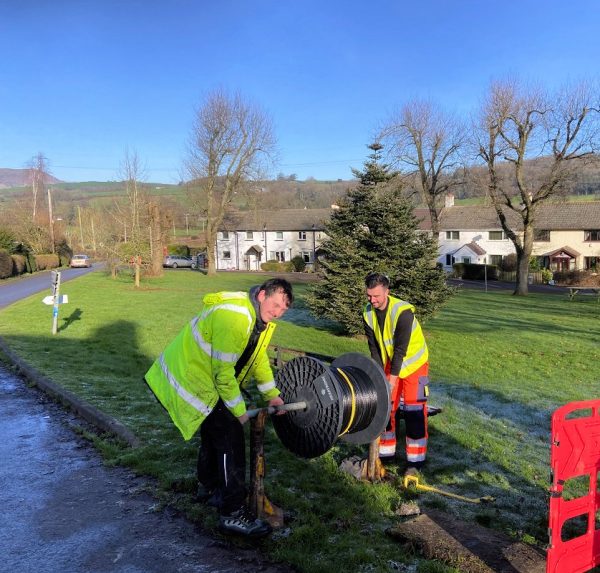1Gbps Full Fibre Goes Live in Rural Llanddewi Rhydderch, Wales

Sixty homes in the tiny rural Monmouthshire (Wales) village of Llanddewi Rhydderch have finally gone live on a new 1Gbps Fibre-to-the-Premises (FTTP) broadband network, which has been installed by Broadway Partners (UK ISP Broadway Broadband) and is intended to complement their existing Fixed Wireless Access (FWA) trial.
The original wireless trial (here), which harnessed both 60GHz “mesh” radio technology and some of the lower 5GHz frequency band, formed part of the Government’s wider 5G Rural Integrated Testbed (5GRIT) project and received a share of £3.5m in public funding (here). More recently Broadway Partners have also been busy building an FTTP based broadband network in the village too (here).
At the time Barry Weaver, Broadway’s Operations Director, informed ISPreview.co.uk that the aim of this was to have a mix of different technologies and the customer can then choose what works best for their particular circumstances.
Advertisement
The network itself, which has now been connected to 60 houses in the village, is capable of gigabit speeds, although at present most local residents are taking their entry-level “Ultrafast 100Mbps” service. One example speedtest.net test showed a ping of 24ms (higher than usual for FTTP – we can get faster on FTTC), downloads of 115.54Mbps and uploads of just 14.56Mbps.
Barry Weaver, COO at Broadway, said:
“We are very pleased to be building fibre networks in Monmouthshire, having been working closely for some time with Monmouthshire County Council and the Department for Digital, Culture, Media and Sport (DCMS), developing the business and commercial case for Full Fibre in even the remotest rural areas.
This is just the beginning: ‘full fibre’ is still only available across a fraction of Monmouthshire, Wales and the UK, and Broadway’s low cost, flexibility and speed of deployment put in a great position to help deliver the Government’s ambitions for ‘Gigabit Connectivity for all’ by 2025.”
Broadway claims that their 100Mbps service is also “understood to be the cheapest Fibre-to-the-Premises deal currently on the market,” although this is debatable since UK ISP Community Fibre can do a symmetric speed 50Mbps FTTP package for £20 per month and 150Mbps for £25. On the other hand any claim of being the cheapest is largely irrelevant due to the extremely limited coverage of both networks.
Otherwise the operator is now proceeding to Phase 2 of their rollout, which aims to connect another 50 properties to the Full Fibre network (this is currently in the design stage, with build due to begin by the end of the month).
After that they’ve already pledged to deploy their FTTP network to a further 50 rural communities across Monmouthshire by the end of 2021 (here). Local communities are being urged to contact them on 0141 465 8500 or via email hello@broadwaybroadband.co.uk in order to express an interest.
Advertisement
Mark is a professional technology writer, IT consultant and computer engineer from Dorset (England), he also founded ISPreview in 1999 and enjoys analysing the latest telecoms and broadband developments. Find me on X (Twitter), Mastodon, Facebook, BlueSky, Threads.net and Linkedin.
« Trials of 1000Mbps Full Fibre Broadband Spotted at UK ISP BT






















































Another altnet going where the big boys fear to tread. Well done.
The problem is how sustainable are all these altnets. Some have had big investments so I’m sure they will be around for some time. But others as mentioned in this article are tiny. How long will they last without grant funding from DcMS? You can’t sustain a business with only a few hundred customers can you?
Once the network is built then you have a significant asset and if the costs of build are mostly covered by grants/vouchers then payback becomes significantly easier to achieve. ISPs that are small but scale FTTP gradually, often through a demand-led approach, generally seem to do better (in terms of economic sustainability) than those that start small but try to grow too fast in challenging rural areas.
I agree with @MJ.
Expanding beyond your business model and or management competencies is a big issue with any SME.
There is a whole bucket load of difference between being an inspirational manager/problem solver or on the ground and being able to organise BigCo – some people can’t make that transition or indeed have the vision of how to do it.
I also agree that once the thing is built and working it is a pretty valuable asset that is saleable as well as hopefully scaleable!
I would **guess**, from the ping, that the local distribution is via FTTP but the backhaul is using microwave? This is sort of inline with their earlier press releases that they would do mixed and replace piecemeal with full fibre?
I agree that there is an issue on sustainability here – those of us with long memories will recall the many community-level fixed wireless operations established on the back of grant funding in the early days of ADSL. Nearly all of those folded when the grants ran out as they were not generating enough money to fund their opex let alone any future capital requirements.
@New_Londoner. To be fair I’ve only seen a few fixed wireless ISPs fold like that and there were additional reasons, although others did fail once ADSL2+ and FTTC reached their areas. At that point the wireless operators either had to adapt and go faster (many of those that did have survived) or they faced a customer bleed back to fixed line (slow death). But we’re talking FTTP above, not fixed wireless, so there are different considerations.
So again we have to be careful with this. This is NOT full-fibre but Mircowave then fibre. Not really FTTP. I cannot believe that the ASA doesn’t stop this. Consumers will think they are getting a premium service when in fact they could be relying on an average wireless backhaul for their service. Judging by the high latency that is what is happening here.
Also although these Altnets are building FTTP networks now, with subsidy from UK tax payers, what happens when the subsidies stop? Usually the builds stop and then the companies slowly disappear. In fairness Mark is correct the fibre networks are valuable but the Microwave backhauls are not. It will be a race to get all the fibre networks linked into one core fibre network before the subsidies run out.
Interesting latency speed. Not too much of a problem for slower broadband speeds but for higher speeds i.e. over 100Mb that kind of latency will not yield great results.
We will see in the future that the quality of network is actually more important than speed.
Also on sustainability if the low earth satellites get anywhere near their promise then poorly designed networks may lose business to the satellite and 5G operators. Although to be fair I’m sure many well designed networks will also lose business to the wireless guys as well.
Interesting people commenting on how the latency indicates microwave is in use for backhaul given microwave is using by high frequency traders due to its superior latency to optical – optical signals bound around inside the fibre at about 2/3rds the speed of light while microwave is very close to the speed of light.
I wouldn’t be all that surprised if these guys have a couple of gigabits of backhaul total, though, whatever the backhaul is.
High frequency trader microwave networks tend to be highly optimised point to point set-ups for low latency but they don’t really carry a lot of data at any one time. Maybe the mesh arrangement increases the latency. Also the signal can still be compromised by the weather (moisture in the air), often a problem in the UK.
It’s a really interesting use of the tech though
If they are using half-decent kit if it starts to hit issues it should row back on modulation on order to compensate for the lower signal quality.
If there’s a bit mesh in use that would increase the latency to an extent.
Either way it still seems very high. I imagine there are other things going on.
Even my inferior BT-supplied service has sub-2 ms latency to the exchange and from here in West Yorkshire only has a 5 ms round trip from exchange to London.
It’s the 24×7 support that’s the fun bit.
CarlIT assumes decent quality Microwave is being used. If it is why is there a 25ms latency?
Full-fibre services from the good altnets are typically less than 6ms to most UK locations with many reporting 1ms latency to local resources.
So this is definitely not a quality network.
I get 0 ms ping on ethernet and usually about 4-6ms on wifi. On community fibre. With ethernet speed of about 940mbps symmetrical on ethernet and 400mbps symmetrical on wifi. As their network grows and more fibre links joined up I bet their latency will drop too. Either way, it is still tons better than anything through a copper phone line. Well done to them.
Lots of reasons why latency could be higher than expected for FTTP:
The test could be over Wi-fi rather than wired Ethernet
The customers network router may be reaching throughput capacity which will cause latency to spike.
Firewalls particularly with DPI enabled will increase latency.
Then you have possibilities within the ISP core network.
Finally with only 1 test available you can’t rule out the test server either.